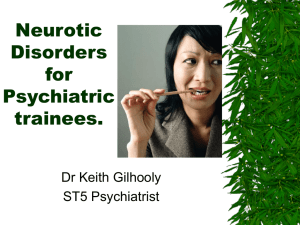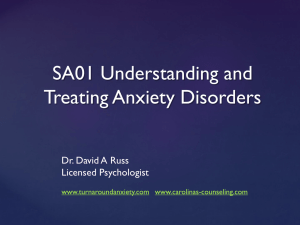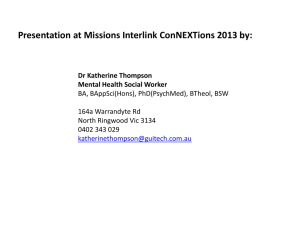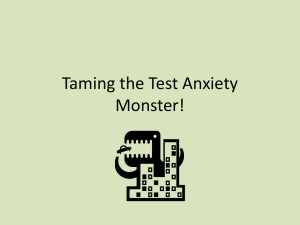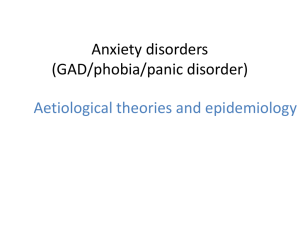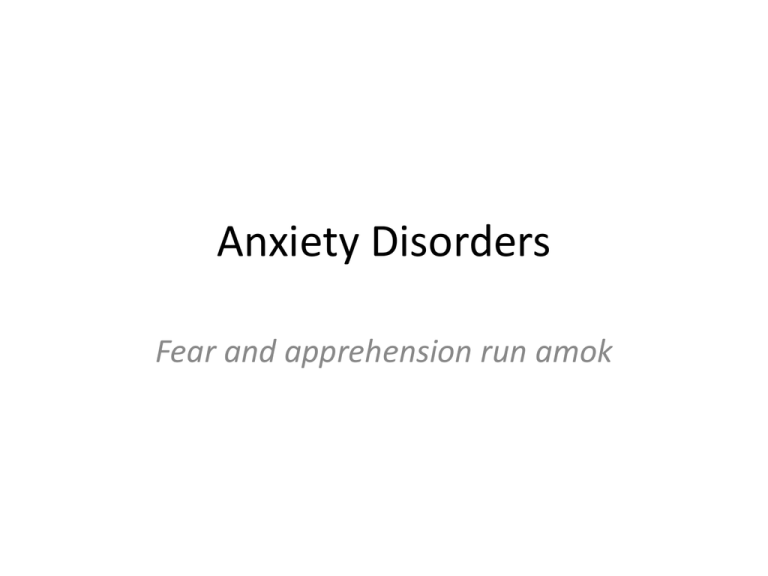
Anxiety Disorders
Fear and apprehension run amok
Definitions
• Anxiety – apprehension over an anticipated
problem
• Fear – reaction to immediate danger
• Both involve sympathetic nervous system
arousal
• Both are adaptive but when they arise
inappropriately misery can follow
Many suffer
• Most common mds – 28% at some point
• Phobias strike the most
• Pervasive costs
1) 2x the medical cost
2) greater risk of heart and other illnesses
3) 2x suicide risk
4) troubles socially and at work
DSM IV TR to DSM 5
• Most disorders remain unchanged
• Panic Disorder (DSM IV TR) now split into
Panic disorder and Agoraphobia
• OCD and Trauma/Stress disorders (PTSD) are
given their own chapters
General Diagnostic Criteria
• Major functional trouble/distress
• Drugs or medical condition not causal
• Lots of overlap between the specific disorders
• Most (except GAD) involve intense fear
Description – Specific phobias
• A disproportionate fear caused by a specific
object or situation
• Recognizing that the fear is not realistic no
longer necessary in DSM 5
• Object or situation are avoided
• High chance that a victim will more than 1
Social Anxiety Disorder
• Persistent, unrealistically intense fear of social
situations involving appraisal or even contact
with unfamiliar people
• Formerly – social phobia disorder
• Great fear of public speaking, talking in class
or to authority figures, meeting new people
• Way beyond simple shyness
• Can severely limit jobs and advancement
Social Anxiety Disorder cont.
• 1/3 are comorbid w/ avoidant personality
disorder, w/ genetic overlap, but less severe
• Can begin in childhood, but usually in teens
• Chronic w/out treatment
• Fears can range from a few to very many
• More fears, more likely comorbid w/
depression and alcohol abuse
Panic Disorder
• Frequent panic attacks unrelated to any
specific trigger and the worry of more to come
• Panic attack – sudden wave of intense terror
accompanied by at least four other symptoms
• Symptoms could include shortness of breath,
racing heart, sweat, fainting, chills, nausea,
trembling, dizziness, numbness/tingling
Panic Disorder:
psychological symptoms
• Derealization – fear that the world is not real
• Depersonalization – a feeling of being outside
of your body
• Also, fear of losing control, of going crazy, of
dying
• 90% report these type of symptoms
• Many want to run away as fast as possible
Recurrence is crucial
• Attacks must be recurrent for at least a month
• Many (more than 25%) have endured one
attack
• Few suffer repeatedly
• Devastating to employment – many cannot
keep a job
Agoraphobia
• Fear of places or situations from which it
would be hard to escape
• Crowds, shopping malls, trains, games
• Many, as a result, don’t leave the house
• And, if they do, it’s only with great distress
• Formerly under Panic Disorder, but few
endure panic attacks
• Significantly impairs day to day function
Generalized Anxiety Disorder (GAD)
• Excessive worry on more days than not about
any kind of events
• Worries are common for everyone but these
are excessive in terms of intensity and time
• Must last for at least 6 months, many chronic
• Symptoms include trouble concentrating,
fatigue, irritability, restlessness, muscle
tension
If you’ve got one …
• More than half get another anxiety diagnosis
at some point
• Especially true for GAD – 80%!
• Many others have subthreshold symptoms
• Why such high comorbidity?
1) symptom overlap, and
2) many causal factors increase risk for more
than 1 disorder
More comorbidity
• Above and beyond other anxiety disorders,
they have high comorbidity with many other
types of mds
• 75% meet criteria for another md!
• 60% for depression alone
• Many suffer from substance abuse and/or
personality disorders
• Also great risk for concurrent medical woes
Does Gender matter?
Yes – women are 2x more likely to suffer.
Why?
a) More likely to report
b) Men think they have control
c) Men are often forced to face fears –
exposure
d) Sadly, women are more often sexually
abused
e) Women seem more physiologically
vulnerable
How about culture?
• Significant variation depending upon what a
culture values, or fears
• Taijin kyofusho – Japanese syndrome involving
deep fear of displeasing others
Manifests by fear of eye contact, blushing,
body odor or deformity
Similar to SAD but the emphasis on the
feelings of others distinguishes
Arises from extreme, traditional concern for
other’s feelings?
More cultural variants
• Kayak-angst – Inuit seal hunters can endure
special type of panic disorder
Features intense fear, disorientation
Alone in a harsh, unforgiving environment
• Koro – Asian phenomenon, grave fear of penis
disappearing into body
• Shenkui – Chinese fear of losing semen due to
masturbation or too much sex
Other aspects of cultural variation
• Low incidence of anxiety disorders in Japan –
bias against reporting?
• Lots of panic disorder in Cambodia – lingering
effects of Khmer rouge genocide? PTSD?
• While some cultural variations have been
explained away, others, including the nature
of complaints do vary from culture to culture
Common Risk factors for all Anxiety
Disorders
• Helps explain high comorbidity
• Big factor arises from the classical
conditioning (CC) of fear responses
• Other factors – genes, personality traits,
cognitive factors – influence how and when
conditioning takes hold
Fear Conditioning – Mowrer’s Two
Factor Model
• Mowrer’s theory
1) through CC we learn to fear a neutral
stimulus (CS) that is repeatedly paired with an
always averse stimulus (UCS)
2) through operant conditioning (OC) we
feel better, doge stress, by avoiding the CS.
Avoiding the CS becomes more and more
likely (reinforcing) because it reduces fear.
Example – Claustrophobia & elevators
• A child is stuck in an elevator for a long period
of time and develops a phobia of elevators
• She has learned to link elevators (CS) with
being trapped in a small space (UCS)
• The child becomes anxious every time she
sees or even thinks about an elevator (CR)
• Avoiding elevators produces great relief
(reinforcement) so it continues – no exposure
How could this start?
• Direct experience – a snake bit you and it hurt
• Modeling – you saw another person bitten or
terrified and it made an impression on you
• Verbal instruction – someone told you hoe
horrible it is to be bitten by a snake
Two other factors
• People who suffer from anxiety disorders
share two qualities
1) they are more susceptible to CC of fear
responses
2)their fears are resistant to extinction –
exposure to extinction trials (CS not followed
by UCS) does not lead to extinction
Genetic influence
• Twin studies reveal a heritability of 20-40% for
anxiety disorders besides panic disorder
• Panic disorder – 50%
• It seems that some genes predispose to all
anxiety disorders while others point to specific
disorders
Neurobiological
• Inappropriate activation and persistence of
the fear circuit is associated with anxiety
disorders
• The amygdala is a major player assigning
excessive fear to stimuli and triggering the
circuit
• Worse yet, the medial prefrontal area, which
can override the too sensitive amygdala, tends
to be compromised in anxiety disorders
Neurobio II
• Neurotransmitters also play a role
• Serotonin problems, or too much
norepinephrine, are linked to anxiety woes
• GABA usually inhibits activity and anxiety
throughout the brain, deficits could hurt
Personality’s Influence
• If yearlings show behavioral inhibition, fearful
reaction to novel stimuli, they often (45%)
show anxiety at 7.
• Genetic – can manifest at four months
• Especially predictive of Social Anxiety Disorder
• Neuroticism – ultra-senrsitivity to adverse
stimuli, another strong predictor of both
anxiety and depression
Cognitive – three theories
• Sustained Negative Beliefs about the Future –
the pervasive conviction that only bad things
are coming
• Common among anxiety disorders
• Maintained by safety behaviors, avoidance
measures that prevent beliefs from reality
testing
Perceived Control
• The belief that you have no control over your
future is characteristic of many anxiety
disorders
• Rough times as a kid may encourage this
outlook
• 70% of anxiety sufferers can identify a crisis
within months of onset
• Backed up by animal studies
Specific Causes - Phobias
• Classical Conditioning – phobias are a
conditioned response maintained by
avoidance behavior
• Could arise from personal trauma, modeling,
or verbal instruction
• When asked though, about ½ don’t remember
• Says more about the failings of memory, than
the viability of the theory
Phobia etiology II
• Many are unaffected by experiences that
cause phobias to develop in others
• Why? risk factors – neurotransmitter deficits,
personality traits, high fear circuit activation
• But only some things cause phobias to arise –
things we have feared for millennia like dogs,
snakes, heights – Prepared Learning
• Other stimuli cause reactions, but soon fade
Causes of Social Anxiety Disorder
• Similar to phobias – developed by CC,
maintained by OC
• Safety behaviors make the problem worse
• From the Cognitive perspective:
1) negative beliefs – I’m a dork & all know it
2) too conscious of internal cues – so alert to
their reactions, they ignore their partner
Panic Disorder – Why do we
exaggerate bodily changes?
• Neurobiological – locus coruleus turns on too
easily causing unnecessary sympathetic
nervous system arousal
• Classical Conditioning – signs of arousal lead
to panic attack, and then become a CS, with
the subsequent panic attack becoming a CR’
also called interoceptive conditioning
Cognition’s role in Panic Disorder
• Interpreting somatic changes as impending
doom
• When someone is warned that somatic
changes are coming, they don’t experience
panic attacks
• When they don’t know, they have catastrophic
interpretations and can sustain panic attacks
Agoraphobia causes
• Fear of Fear – victims overestimate how badly
they will react to stress in public
• Afraid their unease will go viral
Etiology of GAD: Why worry so much?
• GAD is so often a comorbid condition, general
predictors of anxiety disorders are key
• Also, cognitive factors appear crucial
• Worry can be reinforced because it distracts
them from its source, which is more upsetting
• Many have histories of severe trauma
• Worry decreases arousal
• But then fears don’t extinguish and linger
Treatment
• Sadly, few seek treatment – fewer than 20%
• Do they think that’s just the way they are?
• Also, they need specialized help
• General Practitioners under-prescribe and
break off treatment too early
Treatment – You have to face it
• Exposure is the key
• Systematic Desensitization works well, even
w/out relaxation
• CBT is successful, especially if it includes many
aspects of triggering stimuli
• Behaviorists say that we learn a new response,
instead of erasing the old
• Virtual reality technology can help
Specific treatments
• Phobias – in vivo (real life) exposure works
even better than systematic desensitization
• Only a few hours can be enough
• GAD – exposure, starting with role-playing
exercises
• Social skills training helps, especially if safety
behaviors are recognized and overcome
Panic Disorder
• Psychodynamic treatment:
1) id the emotions & causes
2) gain insight
• Small studies revealed this to be effective and
to prevent relapse
• Panic Control Therapy – triggering sensations
are elicited, coping techniques are taught,
ability to create & overcome weakens effect
More treatments
• Agoraphobia – systematic exposure w/
partner, who will not enable works
• GAD – all treatments feature a mix of
behavioral and cognitive components
typically, relaxation exercises are used
attempts to better cope w/ uncertainty
“worry” exercises to weaken its impact
Medications
• Two basic types
• Benzodiazepines such as Valium and Xanax
• Antidepressants
tricyclics
selective serotonin reuptake inhibitors
serotonin-norepinephrine reuptake
inhibitors
• All provide relief from anxiety disorders
Which to choose?
• Antidepressants lack severe withdrawal
effects, they aren’t addictive
• All have side-effects
• Benzodiazepines cause cognitive and motor
problems, even memory lapses
• Tricyclics can cause jitteriness, weight gain,
and others
Why SSRI’s?
•
•
•
•
•
Preferred meds for anxiety disorders
50% stop tricyclics
SSRIs have fewer side-effects
But they can occur
Include restlessness, sleep and sexxproblems,
and headaches
But it doesn’t last
• While meds work, once they aren’t taken,
relapse usually follows
• Accordingly, psychological treatments
featuring exposure are preferred
• Exception – GAD, which can be treated by
buspirone (BuSpar)
Combining meds and psych treatments
• Surprisingly, combining works less than
exposure treatments, of whatever type, alone
• Possibly because meds can impair facing the
fear source






